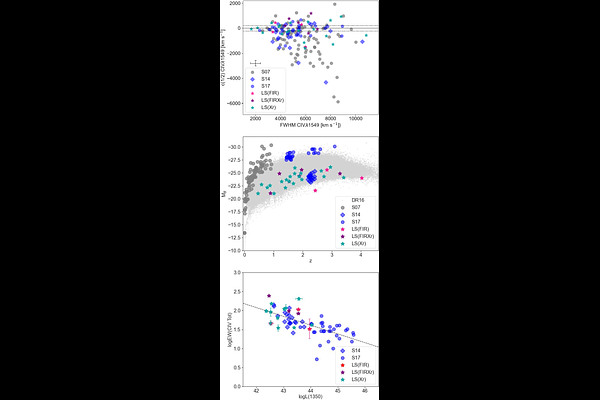The Lockman-SpReSO project. Spectroscopic analysis of Type 1 AGN

The Lockman-SpReSO project. Spectroscopic analysis of Type 1 AGN
Castalia Alenka Negrete, Hector J. Ibarra-Medel, Erika Benitez, Irene Cruz-Gonzalez, Yair Krongold, J. Jesus Gonzalez, Jordi Cepa, Carmen Padilla-Torres, Miguel Cervino, Mirjana Povic, Martin Herrera-Endoqui, Nancy Jenaro-Ballesteros, Takamitsu Miyaji, Mauricio Elias-Chavez, Miguel Sanchez-Portal, Bernabe Cedres, Jacub Nadolny, Mauro Gonzalez-Otero, Bereket Assefa, Hector Hernandez-Toledo, J. Antonio de Diego, J. Ignacio Gonzalez-Serrano, A. M. Perez Garcia
AbstractWe present the first optical-UV spectral systematic analysis of 30 Type 1 AGN selected in the FIR and X-ray in the Lockman-SpReSO Survey. The sample of faint objects (m_B = 19.6-21.8) covers a large redshift range of 0.33 > z > 4.97 with high S/N (~21 on average). A detailed spectral analysis based on the Quasar Main Sequence phenomenology prescription was applied to deblend the principal optical-UV emitting regions. Our sample spans a bolometric luminosity range of 44.85 < log Lbol < 47.87, absolute B-magnitude -20.46 > M_B > -26.14, BH mass of 7.59 < log MBH < 9.80, and Eddington ratio -1.70 < log REdd < 0.56. The analysis shows that 18 high-z objects correspond to Population B, whereas three low-z fall in Populations A2, B1, and B1+. The remaining eight are candidates to be Pop. B and one Pop. A object. None of them are extreme accretors. We looked for tendencies in our sample and compared them with other samples with different selection criteria. Evidence for winds was explored using CIV1549 line half-height centroid cmed finding wind velocities between 941 and -1587 kms-1. This result is consistent with samples with similar ranges of z and M_B. The Baldwin effect showed a slope of -0.23 pm 0.03 dex consistent with previous studies. Spectra from twelve objects in our sample were found in the Sloan Digital Sky Survey Data Release 17 database. We applied the same methodology to compare them to our spectra, finding no evidence of variability.